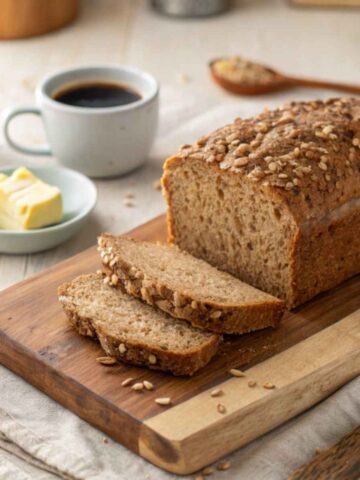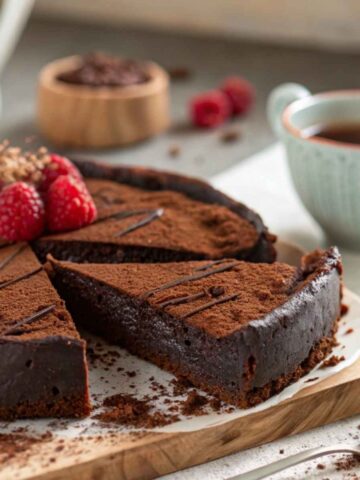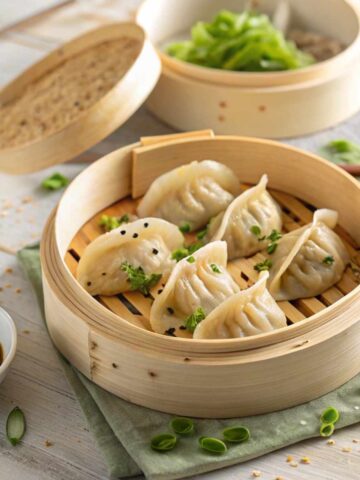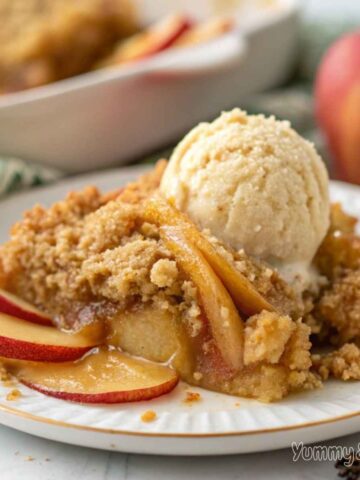Knowing which foods are safe is critical to navigating a gluten-free diet. For people with gluten intolerance, sensitivity, or celiac disease, sticking to gluten-free options is not just a lifestyle choice; it's a health necessity. One common question that arises is: Is White Rice Gluten Free?
In this guide, we'll explore white rice in-depth, discussing whether it's gluten-free, its nutritional profile, cross-contamination risks, and how it fits into a gluten-free diet. You'll also discover tips for safe consumption and gluten-free rice-based recipes.

Jump to:
- What Is Gluten?
- Is White Rice Gluten Free?
- How to Avoid Cross-Contamination:
- Types of White Rice
- How to Include White Rice in a Gluten-Free Diet
- Recipes Using GF White Rice
- Gluten-Free Rice Products: What to Look Out For
- Alternatives to White Rice in a Gluten-Free Diet
- Conclusion
- FAQs
- Gluten-Free Fried Rice Recipe
What Is Gluten?
Before addressing whether white rice is gluten-free, let's first understand gluten. Gluten is a protein found in certain cereals such as wheat, barley, and rye. It's the glue that holds bread together, giving dough its elasticity. However, for some people, gluten can cause adverse health effects.
- Celiac disease is an auto-immune disorder in which the ingestion of gluten damages the small intestine.
- Non-Celiac Gluten Sensitivity: Individuals without celiac disease but still experiencing discomfort when consuming gluten fall into this category.
- Wheat Allergy: People with wheat allergies must avoid gluten to prevent wheat-based products.
Is White Rice Gluten Free?
Yes, White Rice Is Naturally Gluten-Free
White rice, in its pure and natural form, is entirely gluten-free. Rice—whether it's white, brown, black, or wild—does not contain gluten proteins. White rice is an excellent option for those with gluten intolerance or celiac disease. It's naturally simple, easy to digest, and free from the gluten proteins that trigger digestive problems for people with gluten-related conditions.
Why?
Rice grains, unlike wheat, barley, and rye, do not contain gluten proteins. Therefore, rice-based foods, including white rice, are generally safe for gluten-free people. This is excellent news for people who want a versatile, filling, gluten-free option that can easily be incorporated into meals.
Cross-Contamination Concerns: Is Your White Rice Still Safe?
Even though white rice is gluten-free in its natural state, cross-contamination during the harvesting, processing, or packaging stages can introduce gluten into otherwise gluten-free foods. Cross-contamination occurs when gluten-containing grains come into contact with white rice, posing a risk for those with severe gluten sensitivity or celiac disease.
How to Avoid Cross-Contamination:
- Check for Certified Gluten-Free Labels: When purchasing packaged white rice, look for certifications from organizations like the Gluten-Free Certification Organization (GFCO). It guarantees that the product has been tested and processed in a facility that ensures no gluten contamination.
- Be Careful with Bulk Bins: Avoid purchasing rice from bulk bins, as the bins may have previously held gluten-containing grains. Cross-contamination in this environment is expected.
- Use Separate Cooking Utensils: To avoid contamination at home, ensure that pots, pans, and utensils used to cook gluten-containing foods are thoroughly cleaned or separated from those used for gluten-free foods.
- Buy from Reputable Brands: Many reputable rice brands offer gluten-free products and maintain stringent quality control processes.
Types of White Rice
White rice is a staple food worldwide and is often categorized into different types based on the grain length. These varieties are all gluten-free in their natural form:
- Short-Grain White Rice: Sticky and soft when cooked, this rice is great for sushi and creamy dishes.
- Medium-Grain White Rice: A bit more tender, often used in dishes like paella and risotto.
- Long-Grain White Rice: Fluffy and separated when cooked, it is commonly used for everyday meals.
Regardless of the grain length, all types of white rice are naturally gluten-free.
Health Benefits of White Rice
White rice may get a bad rap compared to its whole-grain counterpart, brown rice. However, it still holds some notable health benefits, particularly for individuals with gluten intolerance:
1. Easily Digestible
White rice is less fibrous than brown rice, making it easier to digest, especially for individuals with sensitive stomachs or digestive issues. This makes it a good option for those recovering from illnesses or seeking simple foods that are easy on the gut.
2. Source of Quick Energy
White rice primarily comprises carbohydrates, which provide a quick energy source. It can be an excellent choice for those who need a fast energy boost, such as athletes or individuals with high energy requirements.
3. Fortified with Nutrients
Many varieties of white rice are fortified with essential nutrients like iron and B vitamins during milling. It adds nutritional value to an otherwise crucial staple.
4. Low in Fat and Sodium
White rice is naturally low in fat and sodium, making it a healthy base for many meals. Please keep adding nutrient-dense ingredients like vegetables, lean meats, and healthy fats simple.
How to Include White Rice in a Gluten-Free Diet
1. As a Side Dish
White rice can be served alongside grilled meats, fish, or vegetables, providing a gluten-free base that pairs well with many meals.
2. In Soups and Stews
Use white rice in soups and stews to add texture and body to your meals without gluten.
3. Gluten-Free Rice Bowls
Rice bowls are a delicious and versatile way to use white rice. Combine white rice with your favorite gluten-free toppings like grilled chicken, roasted vegetables, and avocado.
4. As a Substitute for Gluten-Containing Grains
White rice can be substituted for pasta, bread, or couscous in many dishes. It provides the same satisfying texture while keeping your meal gluten-free.
Recipes Using GF White Rice
1. Gluten-Free Fried Rice
This simple fried rice recipe is perfect for a quick meal. It's naturally gluten-free, and you can customize it with your favorite veggies and proteins.
Ingredients:
- 2 cups cooked white rice (cooled)
- Two tablespoons of gluten-free soy sauce
- One tablespoon of sesame oil
- 1 cup vegetables, diced (carrots, peas, peppers)
- Two eggs
- Salt and pepper to taste
Instructions:
- In a large frying pan, heat sesame oil over medium heat.
- Add vegetables and sauté till tender.
- Push the vegetables to one side of the skillet, crack in the eggs, and scramble.
- Stir in the cooked rice and gluten-free soy sauce.
- Cook for 5-7 minutes until heated, then season with salt and pepper.
2. Gluten-Free Rice Pudding
Rice pudding is a comforting dessert that's naturally gluten-free and incredibly easy to make.
Ingredients:
- 1 cup white rice
- 4 cups of milk (or a dairy-free substitute)
- 1/3 cup sugar
- One teaspoon of vanilla extract
- 1/2 teaspoon cinnamon
- Pinch of salt
Instructions:
- Bring the milk to a simmer over medium heat in a large pot.
- Add the white rice, sugar, vanilla extract, cinnamon, and salt.
- Stir constantly, cooking the rice until it absorbs the milk and becomes creamy.
- Remove from heat and serve warm or chilled.
Gluten-Free Rice Products: What to Look Out For
Though plain white rice is gluten-free, some rice-based products can contain gluten, mainly if processed or packaged with added ingredients. Here are some everyday rice-based products to watch out for:
Instant Rice
Instant rice products may sometimes contain gluten-containing additives or flavorings. Always check the packaging for a certified gluten-free label before purchasing.
Flavored Rice Mixes
Pre-seasoned rice mixes, such as those used for quick meal preparation, may include gluten-containing ingredients. Read the label carefully to ensure there are no hidden gluten sources.
Rice Noodles
Rice noodles are typically gluten-free, but some brands may mix wheat flour with rice flour. Verify the ingredients before buying.
Alternatives to White Rice in a Gluten-Free Diet
While white rice is a safe option for a gluten-free diet, several other gluten-free grains and starches can provide variety:
Quinoa
A nutrient-dense seed high in protein and fiber, quinoa is a naturally gluten-free alternative to white rice.
Corn
Corn is another naturally gluten-free option that can be used in various forms, such as polenta or cornmeal.
Potatoes
Potatoes are an excellent gluten-free alternative to rice and can be baked, mashed, or roasted.
Conclusion
To sum up, white rice is naturally gluten-free. It is a safe and healthy option for individuals with gluten intolerance, celiac disease, or anyone looking to avoid gluten in their diet. However, it's essential to be mindful of cross-contamination risks and always check labels when purchasing rice-based products.
White rice is a versatile and nutritious food that can be incorporated into various gluten-free meals, from simple side dishes to more complex recipes like fried rice or rice pudding. You can enjoy this pantry staple's benefits without worry by safely choosing and preparing the rice.
FAQs
All rice varieties, including white, brown, and wild rice, are naturally gluten-free. However, it's important to avoid cross-contamination during processing and packaging.
White rice is a safe option for individuals with celiac disease if it has not been cross-contaminated with gluten.
No, white rice does not contain gluten. It is naturally gluten-free.
Not all instant rice is gluten-free. Check that the packaging is certified gluten-free to ensure that it is safe.
You can pair white rice with gluten-free options, such as grilled vegetables, gluten-free sauces, or lean proteins like chicken and fish.

Gluten-Free Fried Rice Recipe
- Total Time: 25 minutes
- Yield: 3 1x
Description
Thisdelicious and simple gluten-free fried rice is packed with fresh veggies, eggs,and the savory flavor of gluten-free soy sauce. It's a quick and tasty meal,great for lunch or dinner.
Ingredients
- 2 cups cooked white rice (cooled)
- 2 tablespoons gluten-free soy sauce
- 1 tablespoon sesame oil
- 1 cup mixed vegetables (carrots, peas, bell peppers)
- 2 eggs
- 1 tablespoon olive oil
- 2 green onions (chopped (optional for garnish))
- Salt and pepper to taste
Instructions
- Heat Oil: In a large pan or wok, heat 1 tablespoon of olive oil over medium heat.
- Cook Vegetables: Add the mixed vegetables to the pan and sauté until tender, about 5-7 minutes.
- Scrambled eggs: Place the vegetables on the side of the pan. Crack the eggs on the other side and scramble until fully cooked.
- Combine Rice and Sauce: Stir in the cooked rice, followed by gluten-free soy sauce and sesame oil. Mix everything well and cook for an additional 5 minutes until the rice is heated through.
- Season: Season with salt and pepper to taste. Garnish with chopped green onions if desired.
Notes
-
- For added protein, feel free to add chicken, shrimp, or tofu to the dish.
- You can use leftover rice for a better texture, as cold rice works best for fried rice.
- Prep Time: 10 minutes
- Cook Time: 15 minutes
- Category: Main Course
- Cuisine: Asian, gluten-free
Nutrition
- Calories: 350
Keywords: easy fried rice, gluten-free dinner, gluten-free fried rice, quick fried rice








Leave a Reply